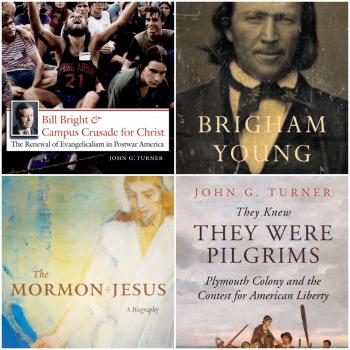Anna Vetter grew up amid the poverty of the Thirty Years War. After marrying, she gave birth to seven children. Around the age of thirty, she grew ill and nearly died. Her husband abused her. A daughter died shortly after birth. Then her visions began.
Anna Vetter saw God, angels, and Jesus Christ. In one vision, she was present at a wedding at which Jesus turned water into wine and then “invited her to dance with him.” In other vision, a mother was ready to deliver a child but could not give birth. Both were about to die, when Anna was able to help the mother deliver a healthy baby boy. She felt the mother’s pain during the birthing process. According to Vetter, the baby represented those residents of Nuremberg wandering in darkness, needing spiritual rebirth. She wrote letters to cities such as Nuremberg and Ansbach, comparing them to adulteress women and condemning them for neglecting the poor.
According to Douglas Shantz’s An Introduction to German Pietism, Anna Vetter was one of a host of women discussed in early accounts of Pietism. They were authors, teachers (often in house churches or conventicles, very infrequently in churches), and prophets. As women exercising spiritual leadership (even if within the constraints of patriarchy), they attracted the notice of Pietism’s orthodox Lutheran critics.
Indeed, the strong presence of female leaders hints at the radical impulses that Shantz sees as the heart of Pietism. “Radical Pietism,” he writes, “was the original, more genuine form of Pietism.” The expression “Radical Pietism,” he further explains, encompasses a wide range of groups and figures: “the Spiritualist-Alchemist model, the Millennialist model, the Conventicle model, and the Sect model. Groups associated with the latter two impulses in particular were wary of traditional churches and largely renounced their ties in favor of new forms of Christian community. Predictions of the imminent fulfillment of biblical prophecies, itinerant preachers, ecstatic expressions of spirituality — all of these characteristics of the Radicals obviously rankled and threatened existing churches. Often persecuted by ecclesiastical and civil authorities, many Pietists emigrated to the British colonies in North America, founding a number of close-knit religious settlements in the eighteenth-century. Groups that trace their heritage to German Pietist radicals include the German Baptists, the Moravian Church, the Church of the Brethren, the Mennonite Brethren, and many others. “Germany’s loss in the seventeenth and eighteenth centuries,” writes Shantz, “has been America’s gain.”
Shantz also expertly explains the centrality of the Bible for Pietists and the ways that the Pietist Bible movement transformed German culture. Although Luther typically receives the credit for introducing the Bible to the masses, Shantz suggests that Lutheranism became “catechism Christianity” and that Pietism “played the decisive role in promoting popular Bible reading and literacy in German lands in teh eighteenth century.” Also, a number of Pietists recognized deficiencies in Luther’s translation and brought forth new versions. For example, Johann Otto Glüser published the Biblia Pentapla, five different German translations in parallel columns, including — somewhat controversially — a Jewish translation of the Old Testament. It was a colossus, the three volumes containing forty-five hundred pages. There were ironies in such examples of Pietist scholarship. “The Enlightenment character of the Biblia Pentapla,” suggests Shantz, “is evident in its goal of encyclopedic comprehensiveness, its recognition of multiple translation possibilities, and its ideal of tolerance and ecumenical-mindedness.” Other Pietists published Bibles with alternative readings and footnotes, utilizing scholarly tools more often associated with Rationalist skeptics but in this case with the aim of inculcating heartfelt devotion to Jesus Christ. Shantz contends that Pietism offered Europeans a “third way besides the options of traditional Orthodoxy and unbelief.” Critics of the Pietists, meanwhile, claimed that they were turned the Bible into a “Babel of confusion.” More positively, Shantz observes that they helped make the eighteenth century “the century of the Bible.”
Pietism gifted many things to subsequent generations of Christians: hymns, such as God Himself Is with Us; the Protestant missionary impulse; the practice of spiritual gifts; and intense devotion to the Word of God, both in Scripture and — above all — in Christ Jesus. Pietists were not the sole source of these foundational aspects of contemporary Protestantism, but they played a far more major role than most American Christians realize.
When I think of Pietists, I tend to think of the Moravians and their white-hot love and passion for Jesus, so passionate it often strikes us as rather unseemly. For instance, Shantz notes that the unmarried Moravians in Ebersdorf composed the following poem to celebrate the birthday of Christian Renatus, son of Count Nikolaus Ludwig von Zinzendorf. Shantz quotes the following lines:
O dear Lord Jesus Christ!
Kiss, kiss, O kiss me please,
Pass through me nuptially.
Make me hot through and through
O hole! [Jesus’s wounded side] O Kyrie Eleis[on].
Other Moravians quickly put an end to such “homoerotic devoutness.” Talk about a sacred romance!
German Pietism, regardless of such perceived excesses, bequeathed much of lasting value to Christians in Europe and America. “Pietism,” concludes Shantz, “reconceived [the] traditional Reformation Protestantism of Luther and Calvin in terms of personal renewal and new birth, conventicle gatherings for Bible study and mutual encouragement, social activism and postmillennialism, and ecumenical cooperation — all in contrast to the confessional and polemical Protestantism that gave rise to the Thirty Years War.”
Shantz’s erudite and engaging book presents an opportunity for English-speaking Christians — some three hundred years later — to dip their toes into this complex and compelling stream.












